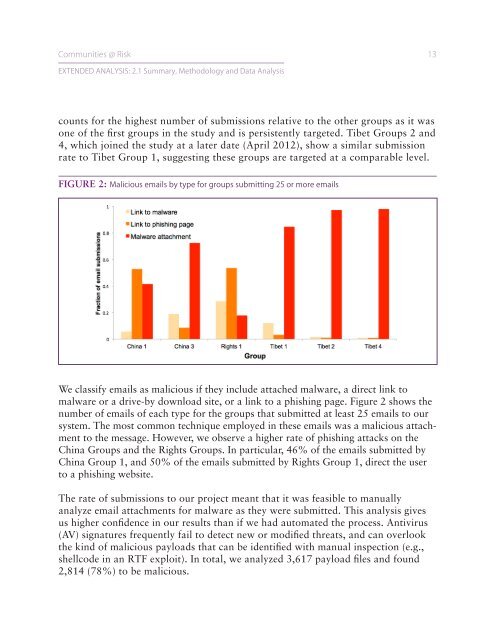2-Extended Analysis-Full
2-Extended Analysis-Full
2-Extended Analysis-Full
Create successful ePaper yourself
Turn your PDF publications into a flip-book with our unique Google optimized e-Paper software.
Communities @ Risk 13EXTENDED ANALYSIS: 2.1 Summary, Methodology and Data <strong>Analysis</strong>counts for the highest number of submissions relative to the other groups as it wasone of the first groups in the study and is persistently targeted. Tibet Groups 2 and4, which joined the study at a later date (April 2012), show a similar submissionrate to Tibet Group 1, suggesting these groups are targeted at a comparable level.FIGURE 2: Malicious emails by type for groups submitting 25 or more emailsWe classify emails as malicious if they include attached malware, a direct link tomalware or a drive-by download site, or a link to a phishing page. Figure 2 shows thenumber of emails of each type for the groups that submitted at least 25 emails to oursystem. The most common technique employed in these emails was a malicious attachmentto the message. However, we observe a higher rate of phishing attacks on theChina Groups and the Rights Groups. In particular, 46% of the emails submitted byChina Group 1, and 50% of the emails submitted by Rights Group 1, direct the userto a phishing website.The rate of submissions to our project meant that it was feasible to manuallyanalyze email attachments for malware as they were submitted. This analysis givesus higher confidence in our results than if we had automated the process. Antivirus(AV) signatures frequently fail to detect new or modified threats, and can overlookthe kind of malicious payloads that can be identified with manual inspection (e.g.,shellcode in an RTF exploit). In total, we analyzed 3,617 payload files and found2,814 (78%) to be malicious.


